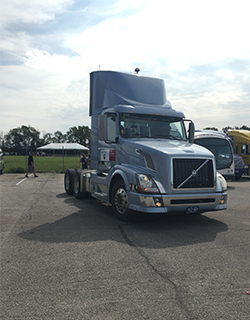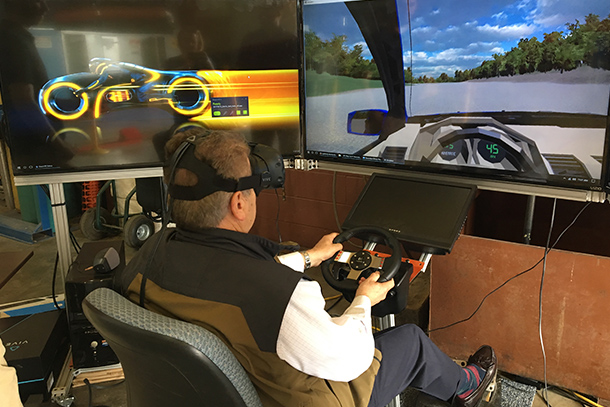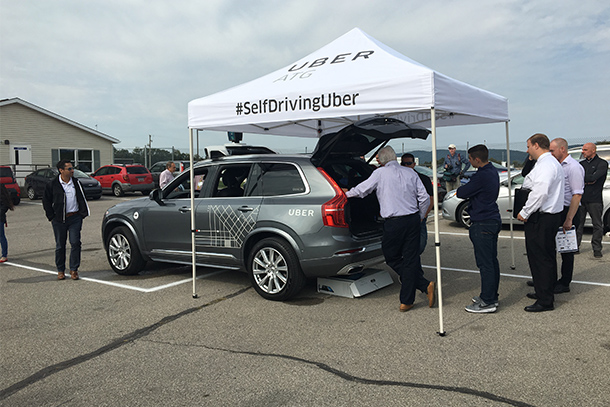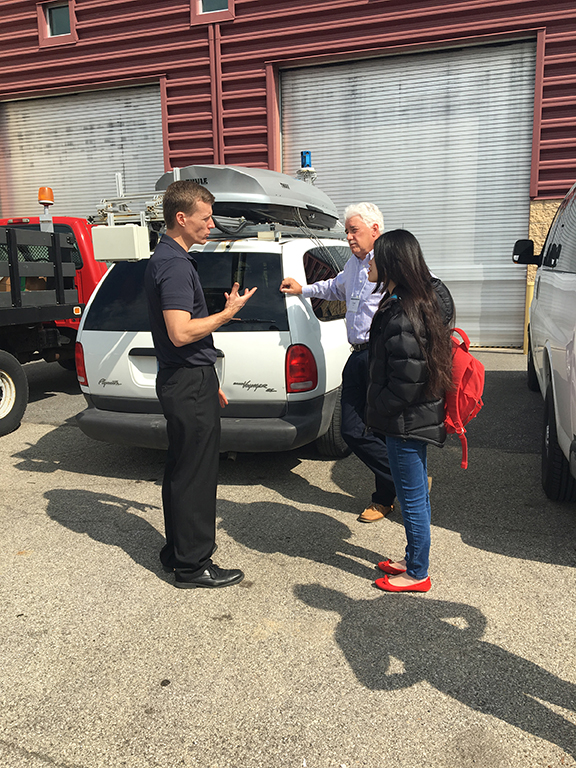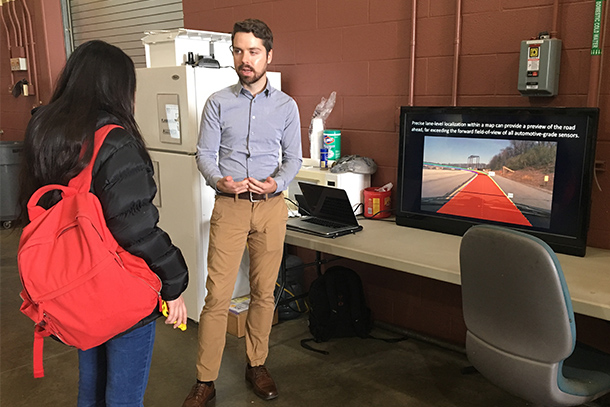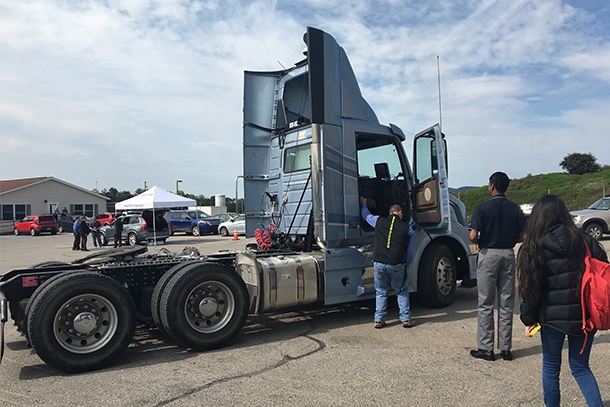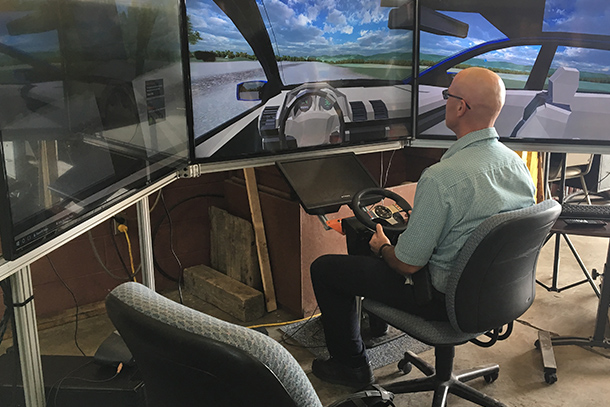
Denny Kovalick, test track manager for The Larson Transportation Institute, takes the highway driving simulator for a test drive before the 2017 Pennsylvania Automated Vehicle Summit commenced at the LTI test track on Sept. 12.
On the road to reality of autonomous vehicles
09/14/2017
By Danica Laub
UNIVERSITY PARK, Pa. – Envision a world in which drivers are actually passengers. Consider a morning commute that gives employees an extra one, two or three hours of sleep, or an evening commute that equally extends the workday. Imagine a mid-week evening or Saturday morning when “soccer” moms and dads no longer need to drive their children to games, dance classes or music lessons. To some people, this may already be reality, because they have been using subways, buses or trains for decades. But, for a large majority of people across the state, country and around the globe living in suburban or rural areas, who rely on personal vehicles to get to and from work, school or leisure activities, the future of transportation is closer than they may think.
According to industry experts, autonomous vehicles are expected to hit the road as early as 2020, in just three short years. But, there are real questions and concerns about what is expected to be the most revolutionary change in transportation since Henry Ford introduced the Model T. How will public policy change? What will highways, rural roads and city streets look like? How should local, county and regional governments and planning organizations prepare their infrastructure and other programs? How will the introduction of autonomous vehicles affect the economy? How will autonomous vehicles impact traffic fatalities? These were just some of the questions that were addressed when thought leaders, academic and industry experts, public officials and planners from across the state recently gathered in Happy Valley for the first Pennsylvania Automated Vehicle Summit, held Sept. 11-12, at the Ramada Conference Center in State College and The Thomas D. Larson Transportation Institute’s test track in Bellefonte.
“You need to participate in the process. You need to own it to make sure your needs are met,” urged Renee Sigel, Pennsylvania division administrator with the Federal Highway Administration, during her opening remarks at the summit. From more accessibility for Americans with disabilities and the elderly to a reduction in the number of highway fatalities, Sigel touched on some of the anticipated benefits of connected and autonomous vehicles. But, Sigel also stressed the importance of communication and cooperation among key stakeholders to ensure the transition is as smooth as possible. Sigel said this includes partnerships between industry and academia, where much of the automated vehicle research begins.
For a hands-on (or “off,” if behind the wheel of an autonomous vehicle) experience, summit attendees headed to The Thomas D. Larson Transportation Institute (LTI) test track in Bellefonte on Tuesday. In addition to a display of Uber’s self-driving Volvo XC90 SUV and test rides in Carnegie Mellon University’s autonomous Cadillac SRX, attendees also had the opportunity to climb into the cab of LTI’s automated Volvo truck to take a lap around the test track, one of 10 federally designated autonomous proving grounds in the country.
To provide a better understanding of the research that goes into autonomous vehicles, Penn State graduate and undergraduate students, under the direction of Sean Brennan, professor of mechanical and nuclear engineering at Penn State, offered demonstrations of heavy-duty fuel economy estimation and powertrain characterization, a real-time six-degrees of freedom map-based vehicle pose estimator and a highway driving simulator to measure risk acceptance.
The highway driving simulator was one of the most popular stations at the summit. With research funded by the National Science Foundation (NSF), Brennan’s students are using the driving simulator to test how drivers adhere to rules of the road differently in real life versus a simulated environment.
“There are fundamental behavioral differences between virtual reality, augmented reality and real environment interactions,” said Nick Dow, a graduate student studying mechanical engineering. “This research will measure how levels of user immersion affect risk-taking and other behaviors.”
But, perhaps one of the most useful areas of research exhibited by Brennan’s team at the summit was the mobile road-mapping platform, explained by Bobby Leary, a doctoral student studying mechanical engineering.
“We have a Larson Transportation mapping vehicle we use to map out the test track using lasers and cameras and our GPS system, so we’re able to actually obtain centimeter-level positioning of particular features on our test track,” said Leary, “Literally, we could throw change down onto the track and be able to detect where the change is at using our sensors.”
Leary’s work takes the road data and samples it down to just the lane markers, which are then used to estimate the position of the vehicle within the map. Ultimately, by lining up the vehicle with what he describes as bread crumbs on the road, Leary is able to command a steering angle for a vehicle to make the vehicle follow a specific path.
Much of the research Brennan and his students gather comes from work they conduct on site at the LTI test track. Designated as one of 10 federal autonomous vehicle proving grounds in the nation in January 2017, the LTI proving grounds offer many of the core capabilities needed to perform connected, automated and autonomous vehicle tests. Two of the most significant capabilities are a secure and safe testing environment and the ability to control the test parameters.
"Pavement markings, signage, signal systems, roadway infrastructure and weather are key factors in the development and testing of autonomous and connected vehicles," said Eric Donnell, professor of civil engineering at Penn State and director of LTI. "Our closed-loop test track at LTI allows our researchers to safely test these things, away from the public."
The 2017 Pennsylvania Automated Vehicle Summit was the first of its kind to be held in Pennsylvania. As the Commonwealth, country and world continue to navigate the road to autonomous and connected vehicles, one thing is certain: self-driving vehicles are going to be a big part of future transportation.


